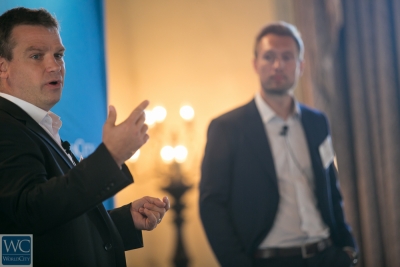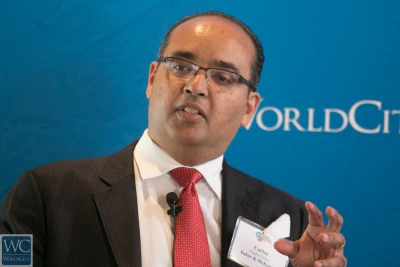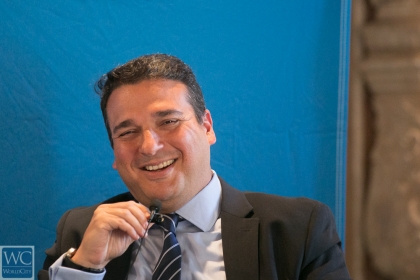HR Americas: Total Rewards, Big Data, social media and the changing role of HR

The practice of human resources is changing quickly, and HR leaders today must be more business-oriented and show corporate chiefs how HR programs contribute to profits and strategic goals.
HR departments also must mobilize new technologies to boost their effectiveness, from promoting jobs on Twitter to offering online training that can engage employees in fun ways like games.
Those were among insights from WorldCity’s Second Annual HR Americas, held Nov. 6-7 to discuss the latest trends in human resources from “Total Rewards” to mining “Big Data.”
“HR is becoming more of a business partner, as opposed to a back office,” summed up Jorge Benitez, retired chief executive of U.S. operations for consulting firm Accenture, where he led 45,000 employees.
Senior executives increasingly see HR as managing a “talent supply chain” and expect HR to figure out “how to use technology and predictive analytics to motivate and enable talent,” said Benitez, pictured above.
Five take-aways from HR Americas
Here are five lessons from panelists, with an in-depth look at each lesson below.
1. Think “Total Rewards.” To attract and retain talent, a good salary and traditional benefits aren’t enough. Today’s employees, especially millennials, increasingly weigh “Total Rewards,” including flexible hours, comfortable work spaces and work-life balance. Ignore that at your peril.
2. Get social. Social media can help with hiring and building an “employment brand.” The public will comment on your company with or without you. Better to engage, as social media booms worldwide.
3. Re-focus training. Make sure that training programs really help employees do their jobs better. Design more targeted programs. Measure employee proficiency, not just classes completed. And why not make learning fun, instead of a chore?
4. Anticipate legal challenges. Check with lawyers and other specialists on complex issues such as taxes and benefits for staff moving between countries or reviews of company emails for employees suspected of stealing. Develop policies and basic contracts to head off potential problems.
5. Mine data. Use computerized data from employees, customers and operations to maximize your business and HR. Even small firms can mine Big Data to boost efficiency.
(For a separate article on what three chief executives shared with HR Americas, click here.)
Total Rewards: Ignore them at your peril
Leading research teams in China, India and South America and working with multinationals, Towers Watson senior economist Magdalena Ramada Sarasola has keen insight into employee trends. And she sees workers increasingly motivated by more than just salary or retirement benefits.

Magdalena Ramada Sarasola, economist at Towers Watson. Photos by Carlos Miller
She’s sees employees looking more at “Total Rewards” based on three pillars. There are “foundational” rewards, such as base pay that offer security, and “performance” rewards, such as merit bonuses that encourage excellence; plus . And last but not least come “career and environmental” rewards, like training and flex-time, which encourage long-term development and day-to-day wellness.
Millennials in particular often decide where to work based on “environmental “factors.
Yet in Latin America, most firms are not yet focusing on that key third pillar, said Ramada.
“It’s about changing your culture more than your costs,” she told the group. One company in the Philippines, for example, saw its productivity soar by by agreeing to let employees work in blue jeans and bring in their cellphones.
Employers can maximize “total rewards” by offering a menu of options, similar to building a financial portfolio. Employees can choose their personal preferences . It’s especially key to offer options that keep “top-performers” and “high-potentials” satisfied and engaged, said Ramada.
To measure attitudes at work, employee surveys are essential. Surveys now show employees in Latin America generally feel “less empowered” than workers in other regions, Ramada said.
What are some best practices to boost “career and environmental rewards?” asked Juan Silva, HR manager in Chile at multinational Iron Mountain.
Helping women better juggle family and work can keep more women in the labor force. Support for women might include flexible hours and child-care on site, said Ramada.
How can companies better engage employees in Latin America who aim to be transferred to the United States? asked Enrique Coello, HR director for Miami-based Econocaribe Consolidators.
One option is to offer them short-term assignments abroad, perhaps for six months, so they can get international experience and then, return home, said Ramada.
Also, check why the employees want to go abroad. If they seek to feel more integrated into a global environment, consider building work-teams across borders and meetings by video-conference. That can help “change their perception” and keep the employees more engaged at home, said Ramada.
Get social: Use Twitter, games and other engaging ways to communicate
It was 2009 in the middle of the Great Recession when Gary Zukowski founded his pioneering business to help companies promote their jobs on social media such as Twitter and Facebook. Many thought he was nuts. Even his children didn’t know what Twitter was back then.

Gary Zukowski of Tweet My Jobs
Now, Zukowski’s North Carolina-based firm, TweetMyJobs, works with nearly 500 customers including such global giants as UPS. It posts some 50,000 to 70,000 job-related tweets per day on Facebook, LinkedIn and other platforms. It often sends out text with video and other “rich media.”
“[Social media] is much more engaging than driving job-seekers to a career page,” Zukowski said of Twitter and other platforms that lets users comment and share. “And it helps you as a company build your employment brand.”
Using social media for recruiting also can help HR departments reduce the time to fill a job. It can boost the quality of hires, based on referrals from people inside or familiar with the company. And those people hired through referrals tend to stay longer with a company, Zukowski said, citing research.

Lorena Keough of Diversified Search.
“Latin America is prime for using social media for recruiting,” he said. That’s because Internet use in the region is soaring, projected to rise from 160 million users last year to 400 million in 2017. Plus, Latin Americans tend to use social media more than others. The region is home to five of the top 10 social-media nations, based on average hours used per month, including Brazil and Colombia, said Zukowski.
Still, social media has its downsides. For example, Glassdoor.com often is used by disgruntled employees to speak negatively about employers, said audience member Lorena Keough, a managing director in Miami for retained executive search firm Diversified Search.
“People are going to bad things about your company, whether you are there or not [on social media.] You should probably know about it,” said Zukowski. “And you should own it,” by responding directly to critics online when possible.

Francia Baez Guzman, managing partner for FBG Consulting
What’s the next big thing in hiring on social media?, asked veteran HR executive Francia Baez Guzman, managing partner for FBG Consulting, who helped organize HR Americas.
“What’s next is definitely mobile,” said Zukowski, pointing to more features for mobile devices such as tablets, as well as new communications platforms that are Social, Local and Mobile dubbed SoLoMo.
Using more pictures, videos and games also is a growing trend, because “rich-media” has been shown to boost response rates by users, he added.
“The companies that are going to be successful in the future are those that make the journey into your company engaging and fun,” said Zukowski. “And game-ification is one way to do that.”
Re-focus training: Target lessons to help people do their jobs better
Too many companies offer training as an end in itself. The aim instead should be to support business goals and help employees do their jobs better.
That was the advice from training specialists Christophe Peron, director for North America for distance learning provider Cross Knowledge, and Daniel Ronshodt, a senior vice president at Denmark’s Area9 Learning Solutions.
Peron and Ronshodt urged companies to re-think training to use multiple formats that fit how different individuals learn and into bite-size pieces that employees can digest as needed.

Christophe Peron, director for North America for distance learning provider Cross Knowledge, and Daniel Ronshodt, a senior vice president at Denmark’s Area9 Learning Solutions.
“You can’t push learning down people’s throats. Learning has to be social,” said Peron, noting most knowledge comes informally and from colleagues, not from formal classes.
Area9’s own history shows the need for individualized training and testing, said Ronsholdt. The company began by offering simulators to train nurses. But many student nurses did not work well with the simulators, because they had knowledge gaps. And those gaps differed in each student.
The challenge for schools and companies is finding ways to help people get the specific skills they lack to do their jobs well. “You cannot measure proficiency in a multiple-choice question,” Ronsholdt said. “And you have to make sure they’re proficient not just today but three months from now or three years.”
What do you think about coaching as a way to improve competencies?, asked Isabel Zuluaga, human resources manager in Miami for LATAM Airlines.
Coaching is very important and face-to-face coaching the best, said Peron. Yet coaching should be targeted to what the individual really needs, or “it could be completely irrelevant,” added Ronsholdt.
International transfers and e-mail checks: Anticipate legal challenges
Moving employees between different countries presents special challenges for HR managers. For example, will a Latin American employee later demand the generous benefits they enjoyed under the labor laws of their home country, such as a 13th month annual salary?
The answer often depends on how the contract for the move is written, said Carlos Felce, chairman of the Latin America employment and labor practice group for law firm Baker & McKenzie.
If the employee is terminated in their homeland and then re-hired abroad, they generally can’t claim homeland benefits. But check the wording on the paperwork. If you write that the reason for the termination was a transfer, the employee can use that to seek homeland benefits, he said.

Carlos Felce, chairman of the Latin America employment and labor practice group for law firm Baker & McKenzie.
The upshot: Get legal advice beforehand to set corporate policies and reduce problems, said Felce.
Terminating an employee before transfer can create other problems, however. The employee could lose their seniority, for example, said audience member Marcelo Fumasoni, vice president and head of human resources for Novartis Latin America Services. Are there other options to better deal with benefits and tax issues on the transfers?
Lawyers as well as some groups of nations in Latin America, including the Pacific Alliance and Mercosur, are looking to develop treaties and laws to regulate expatriate issues within the Latin American region, said panelist Ana Gazarian, founder and chief executive of Employee Mobility Solutions.
“But if we wait for the governments, that will take too long,” said panelist Juan Carlos Varela, office managing shareholder of Littler Mendelson’s offices in Venezuela. He urged the World Bank and other multilateral groups to develop rules that speed a resolution to the expatriate questions.

Ana Gazarian, founder and chief executive of Employee Mobility Solutions.
HR managers also face thorny legal questions related to e-mail and social media use by employees. For example, can a company check the work e-mail of an employee if it suspects that the worker is stealing?
Opinions differ. Varela said yes. But Felce was more circumspect: “Make sure you have a policy in place that allows you to check employee e-mails.”
Mine Big Data to boost employee productivity, satisfaction
An HR veteran at Citigroup, Microsoft, Gillette and Towers Watson, Guillermo Villa never expected he’d be leading a Big Data project as vice president of Global Total Rewards at Royal Caribbean Cruises.
But Villa has been busy for more than a year with a team of industrial engineers working with numbers, spreadsheets and digital data to boost efficiency in HR.
One key area for improvement: Scheduling some 72,000 employees from 160 countries who work for short stints, often for two months at a time, on its 42 ships plying waters worldwide. Moving that crew costs the company about $400 million pery ear for flights, hotels, visas, meals and the like.
To simplify scheduling and other HR tasks, Royal Caribbean is switching to a cloud-based HR software system that will be updated periodically by its supplier. The system will replace the current hodgepodge of software with patches, including some added through acquisitions of other companies.
Already, Royal Caribbean is saving millions of dollars in the transition.
In cleaning its data for the new system, the company found some hiring partners did not enter employee information correctly – for instance, omitting spaces in names that later made it hard to issue plane tickets for those workers. Royal Caribbean now has cut its roster of hiring partners from roughly 300 to 80, keeping those with the cleanest data and best results.

Juan Carlos Varela, co-chair of the Latin America Practice Group at Littler Global.
The company also has figured out ways to slash transport costs for workers while also boosting employee satisfaction ratings with the transit process.
It first used software to find less expensive flights – replacing a non-stop to Miami with stopovers in London or Frankfurt, for example. Next, it gained satisfaction points by surveying employees and booking them when possible with their preferred airline and preferred hotel during the trip, said Villa.
“That project saved us $8 million just on flight expenses,” said Villa. “And employee ratings went from not acceptable to a bit more than acceptable.”
Villa said most HR departments use data in a “reactive” way to measure such basics as head count, turnover and sales per employee.
Some are “pro-active” with data, producing reports for leaders on a dashboard that is regularly updated and can track patterns such as employee diversity indexes.
“The next level is more strategic data use,” said Villa. At Royal, that involves figuring out new ways to meet business needs, such as scheduling employees in teams that have earned higher guest satisfaction ratings. More satisfied guests tend to spend more, return more and make more referrals, said Villa.
“For the future, the question is: How can you use predictive analytics?,” said Villa. “Just 4 percent of companies are there now.”
HR Americas is the final event this year for HR Connections, one of six event series organized by media company WorldCity to bring together executives of multinationals.
The conference was sponsored by the University of Miami School of Business Administration, ECS Partners International, Diversified Search, Employee Mobility Solutions and Littler Global.